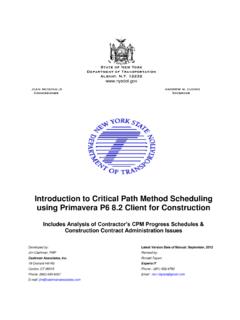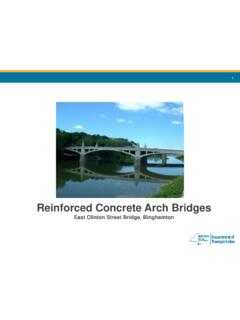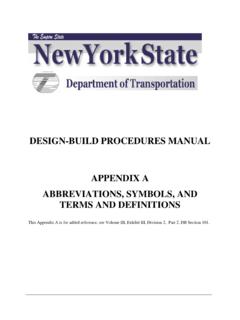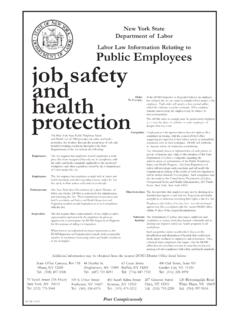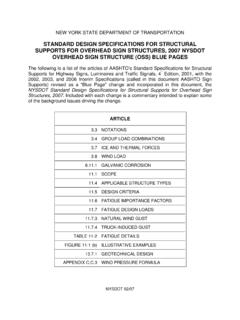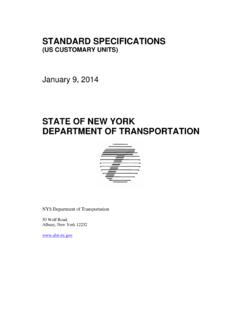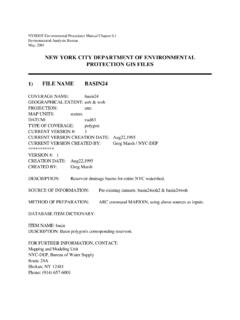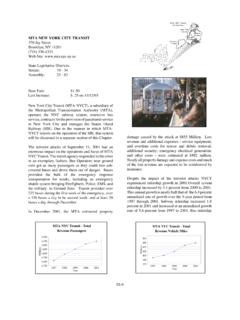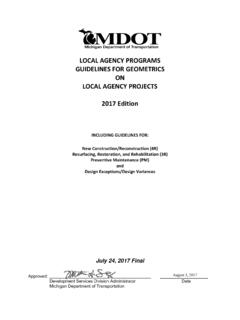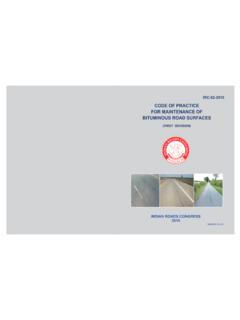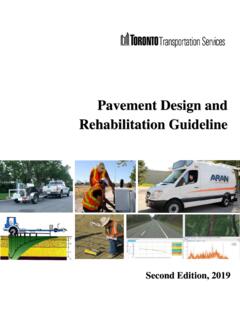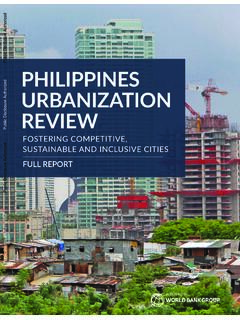Transcription of HIGHWAY DESIGN MANUAL Chapter 7 - New York State ...
1 HIGHWAY DESIGN MANUAL Chapter 7 Resurfacing, Restoration, and rehabilitation (1R, 2R and 3R) Revision 98 (Limited Revision) September 16, 2021 Issued by Engineering Bulletin 21-045 Effective with DESIGN Approval on or after Jan. 1, 2022 RESURFACING, RESTORATION, AND rehabilitation 7-1 EB 21-045 01/01/2022 Section Changes Exhibit 7-8 Note 3 was edited to change the minimum wide curb lane width ( , shared lane width) from 12 ft. to 13 ft. This ensures consistency with HDM Ch 2, which sets the minimum shared lane width at 13 ft. Exhibit 7-10 Ramp Critical DESIGN Elements Based on "Standards of the Day": separate values provided for left shoulder width with 2 lanes in one direction and for 3 lanes in one direction Section New section added on Potential 2R and 3R Efficiencies.
2 Includes new Exhibit 7-14. RESURFACING, RESTORATION, AND rehabilitation 7-2 EB 21-045 01/01/2022 TABLE OF CONTENTS INTRODUCTION .. 4 PROJECT DEVELOPMENT .. 5 Determining the Project Type .. 5 Project Process and DESIGN Approval Document ..10 FREEWAY AND NON-FREEWAY 1R PROJECTS .. 11 Definition of 1R ..11 1R Requirements ..11 FREEWAY AND NON-FREEWAY 2R PROJECTS .. 18 Definition of 2R Projects ..18 NON-FREEWAY 3R PROJECTS .. 21 Definition of Non-Freeway 3R ..21 DESIGN Criteria (Critical DESIGN Elements and Other DESIGN Parameters) ..24 Horizontal Curve Evaluations ..32 FREEWAY 3R PROJECTS .. 34 Definition of Freeway Resurfacing, Restoration & rehabilitation (3R).
3 34 Geometric DESIGN Standards ..35 DESIGN PROJECT DELIVERY .. 40 Timing of Resurfacing ADA and Safety Work ..40 Preparation of Contract Documents & Implementation ..40 Potential 2R and 3R Efficiencies ..42 SAFETAP REPORTING FOR 1R & 2R PROJECTS .. 45 ADA REPORTING FOR NONFREEWAY 1R, 2R & 3R PROJECTS .. 45 REFERENCES .. 48 RESURFACING, RESTORATION, AND rehabilitation 7-3 EB 21-045 01/01/2022 LIST OF EXHIBITS Exhibit 7-1 Resurfacing ADA and Safety Assessment Form (Page 1 of 2) .. 8 Exhibit 7-1 Resurfacing ADA and Safety Assessment Form (Page 2 of 2) .. 9 Exhibit 7-1a 1R Project Pavement Alteration Curb Ramp & ROW Logic .. 17 Exhibit 7-2 2R Screening/Scoping Checklist (Page 1 of 2).
4 19 Exhibit 7-2 2R Screening/Scoping Checklist (Page 2 of 2) .. 20 Exhibit 7-3 Non-Freeway 3R Screening/Scoping Checklist (Page 1 of 2) .. 22 Exhibit 7-3 Non Freeway 3R Screening/Scoping Checklist (Page 2 of 2) .. 23 Exhibit 7-4 Minimum Lane and Shoulder Widths for Rural Highways .. 26 Exhibit 7-5 Lane and Shoulder Widths for Widening Rural Highways .. 26 Exhibit 7-6 Horizontal 27 Exhibit 7-7 Minimum Stopping Sight Distance (SSD) .. 28 Exhibit 7-8 Minimum Lane and Shoulder Widths for Urban 30 Exhibit 7-9 Lane and Shoulder Width for Widening Urban Highways .. 31 Exhibit 7-10 Mainline Critical DESIGN Elements Based on "Standards of the Day"4,5 .. 38 Exhibit 7-11 Ramp Critical DESIGN Elements Based on "Standards of the Day"3, 39 Exhibit 7-12 Timing of ADA and Safety Related Work for Resurfacing Projects.
5 41 Exhibit 7-14 Potential 2R and 3R Efficiencies .. 44 Exhibit 7-13 ADA Reporting Tables (Page 1 of 2) .. 46 Exhibit 7-13 ADA Reporting Tables (Page 2 of 2) .. 47 RESURFACING, RESTORATION, AND rehabilitation 7-4 EB 21-045 01/01/2022 INTRODUCTION INTRODUCTION The deterioration of our transportation infrastructure in New York State has been well documented and the Department has a duty to maintain facilities constructed with federal funds per 23 USC 116(a). The State is faced with more service and safety needs than can be met with available funds. Extensively upgrading facilities, which perform at acceptable levels and do not have a documented safety deficiency, to current standards for new or reconstruction projects is not cost effective.
6 Available dollars must be used to preserve and repair as many miles of highways and as many bridges as practicable. This goal can be achieved on a project by project basis using engineering skills to treat known and potential safety and operational problems. Resurfacing (1R) and restoration and rehabilitation (2R/3R) projects were developed to help extend the State 's limited resources to achieve this goal. Resurfacing is defined as all full width surface inlays and overlays including micro-surfacing and thin lift overlays, cape sealing (chip seal with a double microsurfacing), and in-place asphalt recycling techniques that place or replace top courses on non-freeways or top and binder pavement course(s) on freeways to extend or renew the existing pavement DESIGN life and to improve serviceability while not degrading safety.
7 Restoration and rehabilitation are defined as the multicourse pavement structural work required to return the existing pavement to a suitable condition for resurfacing while enhancing HIGHWAY safety. This includes work necessary to return the roadway, including the shoulder, roadside, bridges and appurtenances to a condition of structural or functional adequacy. Examples of restoration and rehabilitation include box out widenings, rubblizing, and crack & seat work. Treatments that serve solely to seal and protect the road surface, improve friction, and control splash and spray are not 1R and do NOT require safety assessments ( , SAFETAP), ditch cleaning, superelevation, etc.
8 Some examples of the types of treatments that would normally be considered maintenance are: painting or striping lanes, crack filling and sealing, surface sealing, chip seals, slurry seals, fog seals, scrub sealing, joint crack seals, joint repairs, dowel bar retrofit, spot high-friction treatments (< miles), diamond grinding, and pavement patching. In most cases, the combination of several maintenance treatments occurring at or near the same time may qualify as a 1R project. The purpose of this Chapter is to provide the basic scope of work and DESIGN criteria for 100% State funded and federally funded single and multiple course overlays and inlays for both NYSDOT and OGS let projects.
9 This Chapter is not all inclusive. Other chapters and Engineering Instructions continue to provide requirements and guidance for DESIGN elements not modified by this Chapter , such as asset management, pavement evaluation, pavement DESIGN , traffic control devices, guide rail, accommodation of pedestrians and bicyclists, drainage, utilities, landscaping, driveways, etc. RESURFACING, RESTORATION, AND rehabilitation 7-5 EB 21-045 01/01/2022 PROJECT DEVELOPMENT PROJECT DEVELOPMENT One of the major decisions is to determine the appropriate type of project to address the needs and resulting objectives.
10 Prematurely deciding on a resurfacing project or deciding not to gather needed data defeats the scoping process. This can lead to a failure to identify important problems that need treatment, selecting the wrong type of project, or designing an incomplete solution. Accordingly, it is essential that functional group representation on the scoping team be emphasized to reduce the possibility of this occurring. The NYSDOT Comprehensive Pavement DESIGN MANUAL (CPDM) describes pavement evaluation, accepted treatment alternatives (ranging from preventive maintenance to reconstruction) and provides guidance on selection procedures. The NYSDOT Project Development MANUAL (PDM) covers the project development procedures for maintenance, simple, moderate and complex projects that include 1R, 2R and 3R projects.
